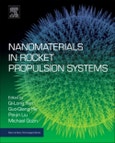Nanomaterials in Rocket Propulsion Systems covers the fundamentals of nanomaterials and examines a wide range of innovative applications, presenting the current state-of-the-art in the field. Opening with a chapter on nano-sized energetic materials, the book examines metal nanoparticles-based fuels, ballistic modifiers, stabilizers and catalysts as the components of rocket propellants. Hydrogen storage materials for rocket propulsion based on nanotubes are then discussed, as are nano-porous materials and metal organic frameworks, nano-gelled propellants, nano-composite ablators and ceramic nano-composites. Other applications examined include high thermal conductivity metallic nano-composite nozzle liners, nano-emitters for Coulomb propulsion of space-crafts, and highly thermostable nano-ceramics for rocket motors.
The book finishes with coverage of combustion of nano-sized rocket fuels, nano-particles and their combustion in micro- and nano-electromechanical systems (MEMS/NEMS), plasma propulsion and nano-scale physics. Users will find this to be a valuable resource for academic and government institutions, professionals, new researchers and graduate students working in the application of nanomaterials in the aerospace industry.
Please Note: This is an On Demand product, delivery may take up to 11 working days after payment has been received.
Table of Contents
1. 2-Dimentional Energetic Nanomaterials for Insensitive Solid Rocket Propellants2. Metal Nanoparticles and Their Combustion Behaviour
3. Catalytic Effects of Solid Propellants by Inorganic Nanoaddtives
4. Combustion of Nanothermites in Micro Propulsion Systems
5. Developments in Flat-Panel Nano-Particle MEMS/NEMS Thrusters
6. Preparation of Metal Nanoparticles and their Combustion in Composite Propellants
7. Recent Advances in Nanoelectromechanical Systems
8. Polymer Nanocomposites for Rocket Ablators
9. Effect of Metal Nanoparticles on Processing and Performances of Composite Propellants
10. Highly Thermal Conductive Nanocomposite for Nozzle Liners
11. Nanoparticles-based Electric Propulsion for Space Exploration
12. Plasma Propulsion and Plasma-based Nanotechnology
13. Nanoscale Energetic Materials: Particle Processing Technology
14. Nano-gelled Cryogenic Propellants with Nano-particulate Additives








